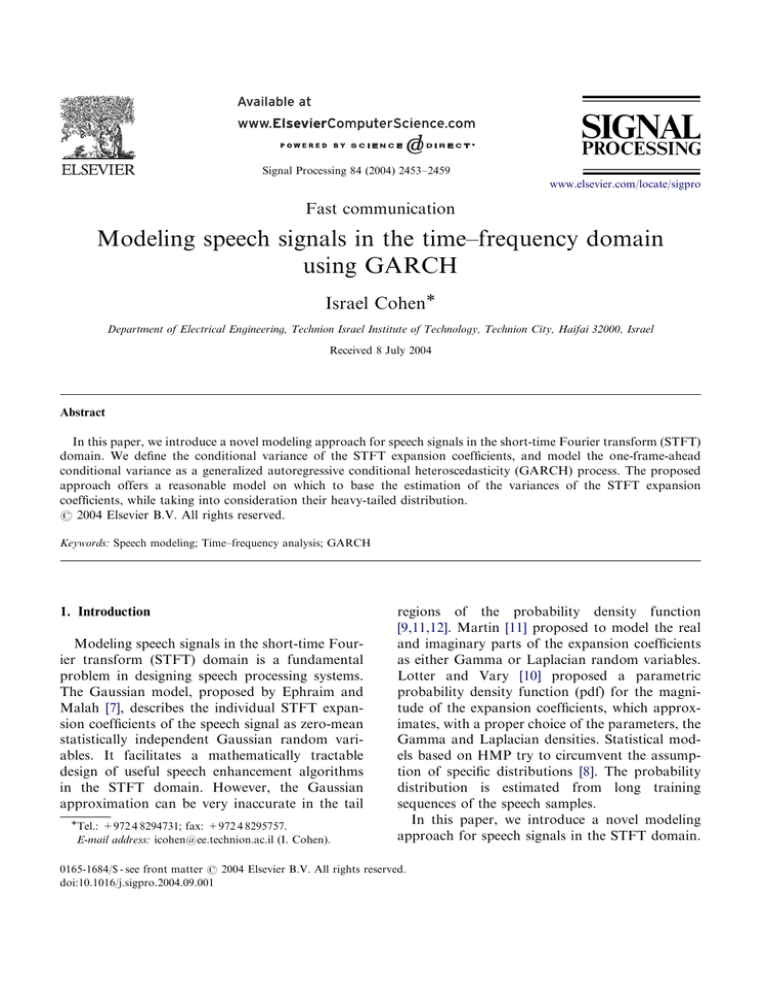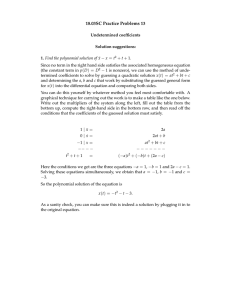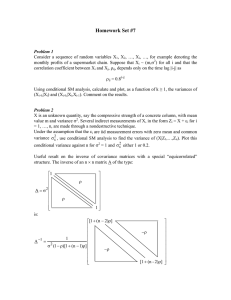
ARTICLE IN PRESS
Signal Processing 84 (2004) 2453–2459
www.elsevier.com/locate/sigpro
Fast communication
Modeling speech signals in the time–frequency domain
using GARCH
Israel Cohen
Department of Electrical Engineering, Technion Israel Institute of Technology, Technion City, Haifai 32000, Israel
Received 8 July 2004
Abstract
In this paper, we introduce a novel modeling approach for speech signals in the short-time Fourier transform (STFT)
domain. We define the conditional variance of the STFT expansion coefficients, and model the one-frame-ahead
conditional variance as a generalized autoregressive conditional heteroscedasticity (GARCH) process. The proposed
approach offers a reasonable model on which to base the estimation of the variances of the STFT expansion
coefficients, while taking into consideration their heavy-tailed distribution.
r 2004 Elsevier B.V. All rights reserved.
Keywords: Speech modeling; Time–frequency analysis; GARCH
1. Introduction
Modeling speech signals in the short-time Fourier transform (STFT) domain is a fundamental
problem in designing speech processing systems.
The Gaussian model, proposed by Ephraim and
Malah [7], describes the individual STFT expansion coefficients of the speech signal as zero-mean
statistically independent Gaussian random variables. It facilitates a mathematically tractable
design of useful speech enhancement algorithms
in the STFT domain. However, the Gaussian
approximation can be very inaccurate in the tail
Tel.: +972 4 8294731; fax: +972 4 8295757.
E-mail address: icohen@ee.technion.ac.il (I. Cohen).
regions of the probability density function
[9,11,12]. Martin [11] proposed to model the real
and imaginary parts of the expansion coefficients
as either Gamma or Laplacian random variables.
Lotter and Vary [10] proposed a parametric
probability density function (pdf) for the magnitude of the expansion coefficients, which approximates, with a proper choice of the parameters, the
Gamma and Laplacian densities. Statistical models based on HMP try to circumvent the assumption of specific distributions [8]. The probability
distribution is estimated from long training
sequences of the speech samples.
In this paper, we introduce a novel modeling
approach for speech signals in the STFT domain.
0165-1684/$ - see front matter r 2004 Elsevier B.V. All rights reserved.
doi:10.1016/j.sigpro.2004.09.001
ARTICLE IN PRESS
2454
I. Cohen / Signal Processing 84 (2004) 2453–2459
Autoregressive conditional heteroscedasticity
(ARCH) models, introduced by Engle [6] and
generalized by Bollerslev [1], are widely used in
various financial applications such as risk management, option pricing, foreign exchange, and the
term structure of interest rates [2]. They explicitly
parameterize the time-varying volatility in terms of
past conditional variances and past squared
innovations (prediction errors), while taking into
account excess kurtosis (i.e., heavy tail behavior)
and volatility clustering, two important characteristics of financial time-series. Speech signals in the
STFT domain demonstrate both ‘‘variability
clustering’’ and heavy tail behavior. When observing a time series of successive expansion coefficients in a fixed frequency bin, successive
magnitudes of the expansion coefficients are highly
correlated, whereas successive phases can be
assumed uncorrelated. Hence, the variability of
the expansion coefficients is clustered in the sense
that large magnitudes tend to follow large
magnitudes and small magnitudes tend to follow
small magnitudes, while the phase is unpredictable. Modeling the time trajectories of the expansion coefficients as generalized ARCH (GARCH)
processes offers a reasonable model on which to
base the variance estimation, while taking into
consideration the heavy-tailed distribution.
This paper is organized as follows. In Section 2,
we review the GARCH model. In Section 3, we
define conditional variance in the STFT domain,
and model the one-frame-ahead conditional variance as a GARCH process. In Section 4, we
address the problem of estimating the model
parameters. Finally, in Section 5, we demonstrate
the application of the proposed model to speech
enhancement.
subtracting from yt its conditional expectation
given the information through time t 1;
2. GARCH model
s2t ¼ k þ
t ¼ yt Efyt jct1 g:
The conditional variance (volatility) of yt given the
information through time t 1 is by definition the
conditional expectation of 2t ;
s2t ¼ varfyt jct1 g ¼ Ef2t jct1 g:
(2)
The ARCH and GARCH models provide a rich
class of possible parametrization of conditional
heteroscedasticity (i.e., time-varying volatility).
They explicitly recognize the difference between
the unconditional variance Ef½yt Efyt g2 g and
the conditional variance s2t ; allowing the latter to
change over time. The fundamental characteristic
of these models is that magnitudes of recent
innovations provide information about future
volatility.
Let fzt g be a zero-mean unit-variance white
noise process with some specified probability
distribution. Then a GARCH model of order
ðp; qÞ; denoted by t GARCHðp; qÞ; has the
following general form:
t ¼ st zt ;
(3)
s2t ¼ f ðs2t1 ; . . . ; s2tp ; 2t1 . . . ; 2tq Þ;
(4)
where st is the conditional standard deviation
given by the square root of (4). That is, the
conditional variance s2t is determined by the values
of p past conditional variances and q past squared
innovations, and the innovation t is generated by
scaling a white noise sample with the conditional
standard deviation. The ARCHðqÞ model is a
special case of the GARCHðp; qÞ model with p ¼ 0:
The most widely used GARCH model specifies a
linear function f in (4) as follows:
q
X
ai 2ti þ
i¼1
Let fyt g denote a real-valued discrete-time
stochastic process, and let ct denote the information set available at time t (e.g., fyt g may represent
a sequence of observations, and ct may include the
observed data through time t). Then, the innovation (prediction error) t at time t in the minimum
mean-squared error (MMSE) sense is obtained by
(1)
p
X
bj s2tj ;
(5)
j¼1
where the values of the parameters are constrained
by
k40; ai X0; bj X0;
q
p
X
X
ai þ
bj o1:
i¼1
j¼1
i ¼ 1; . . . ; q; j ¼ 1; . . . ; p;
ARTICLE IN PRESS
I. Cohen / Signal Processing 84 (2004) 2453–2459
The first three constraints are sufficient to ensure
that the conditional variances fs2t g are strictly
positive. The fourth constraint is a covariance
stationarity constraint, which is necessary and
sufficient for the existence of a finite unconditional
variance of the innovations process [1].
Many financial time-series such as exchange
rates and stock returns exhibit a volatility clustering phenomenon, i.e., large changes tend to follow
large changes of either sign and small changes tend
to follow small changes. Eq. (5) captures the
volatility clustering phenomenon, since large
innovations of either sign increase the variance
forecasts for several samples. This in return
increases the likelihood of large innovations in
the succeeding samples, which allows the large
innovations to persist. The degree of persistence is
determined by the lag lengths p and q; as well as
the magnitudes of the coefficients fai g and fbj g:
Furthermore, the innovations of financial timeseries are typically distributed with heavier tails
than a Gaussian distribution. Bollerslev [1] showed
that GARCH models are appropriate for heavytailed distributions.
2455
are
statistically
indewhere
fV tk jH tk
1 g
pendent complex Gaussian random variables with
zero-mean, unit variance, and independent and
identically distributed (IID) real and imaginary
parts:
EfV tk jH tk
1 g ¼ 0;
EfjV tk j2 jH tk
1 g ¼ 1:
(8)
Accordingly, the expansion coefficients fX tk jH tk
1 g
are conditionally zero-mean statistically independent Gaussian random variables given their
standard deviations fstk g: The real and imaginary
parts of X tk under H tk
1 are conditionally IID
random variables given stk :
Let Xt0 ¼ fX tk jt ¼ 0; . . . ; t; k ¼ 0; . . . ; K 1g represent the set of expansion coefficients up to
n
t
frame t; and let s2tkjt ¼ EfjX tk j2 jH tk
1 ; X0 g denote
tk
the conditional variance of X tk under H 1 given the
expansion coefficients up to frame t: Then, we
assume that the one-frame-ahead conditional
variance s2tkjt1 evolves according to a
GARCHð1; 1Þ process:
s2tkjt1 ¼ s2min þ mjX t1;k j2 þ dðs2t1;kjt2 s2min Þ;
(9)
3. Speech modeling
Let xðnÞ denote a speech signal, and let its STFT
expansion coefficients be given by
X tk ¼
K
1
X
where
s2min 40;
xðn þ tMÞhðnÞ e
jð2p=KÞnk
;
(6)
n¼0
where t is the time frame index (t ¼ 0; 1; . . .), k is
the frequency-bin index (k ¼ 0; 1; . . . ; K 1), hðnÞ
is an analysis window of size K (e.g., Hamming
window), and M is the framing step (number of
samples separating two successive frames). Let H tk
0
and H tk
1 denote, respectively, hypotheses of signal
absence and presence, and let stk denote a binary
state variable which indicates signal presence, i.e.,
tk
stk ¼ 0 when H tk
0 ; and stk ¼ 1 when H 1 : Let
2
tk
2 n
stk ¼ EfjX tk j jH 1 g denote the variance of an
expansion coefficient X tk under H tk
1 :
We assume that given fstk g and fstk g; the
expansion coefficients fX tk g are generated by
X tk ¼ stk V tk ;
(7)
mX0;
dX0;
m þ do1
(10)
are the standard constraints imposed on the
parameters of the GARCH model. The parameters
m and d are, respectively, the moving average and
autoregressive parameters of the GARCH(1,1)
model, and s2min is a lower bound on the variance
of X tk under H tk
1 :
The variances fs2tk g are hidden from direct
observation, in the sense that even under perfect
conditions of zero noise, their values are not
directly observable, but have to be estimated from
the available information. If the available information includes the set of expansion coefficients
up to frame t 1; then an MMSE estimator for s2tk
can be obtained by
2 ¼ Efs2 jH tk ; Xt1 g:
sc
tk
1
0
tk
(11)
ARTICLE IN PRESS
I. Cohen / Signal Processing 84 (2004) 2453–2459
2456
From (7), (8) and the definition of the conditional
variance s2tkjt ; we have
n
t1
s2tkjt1 ¼ EfjX tk j2 jH tk
1 ; X0 g
t1
¼ Efs2tk jV tk j2 jH tk
1 ; X0 g
t1
2
tk
¼ Efs2tk jH tk
1 ; X0 gEfjV tk j jH 1 g
2 :
¼ sc
tk
ð12Þ
Xt1
0 ;
the conditional variance
Therefore, given
s2tkjt1 is an MMSE estimator for s2tk :
It should be noted that in speech enhancement
applications, the available information is generally
the set of noisy spectral components up to frame t;
rather than the clean spectral components up to
frame t 1: In that case, an estimate for stk is
derived from the available noisy data [4].
4. Model estimation
In this section we address the problem of
estimating the model parameters s2min ; m and d:
The maximum-likelihood (ML) estimation approach is commonly used for estimating the
parameters of a GARCH model. We derive the
ML function of the model parameters by using the
expansion coefficients in some interval t 2 ½0; T:
For simplicity, we assume that the parameters are
constant during the above interval and are
independent of the frequency-bin index k: In
practice, the speech signal can be divided into
short time segments and split in frequency into
narrow subbands, such that the parameters can be
assumed to be constant in each time–frequency
region.
Let H1 ¼ ftkjstk ¼ 1g denote the set of time–frequency bins where the signal is present, and let
/ ¼ ½s2min ; m; d denote the vector of unknown
parameters. Then for tk 2 H1 ; the conditional
distribution of X tk given its standard deviation stk
is Gaussian:
1
jX tk j2
pðX tk jstk Þ ¼ 2 exp 2
; tk 2 H1 :
stk
pstk
(13)
Furthermore, fX tk jstk ; tk 2 H1 g are statistically
independent. We showed in Section 3 that the
MMSE estimate of s2tk given the expansion
coefficients up to frame t 1 is s2tkjt1 : The
conditional variance s2tkjt1 can recursively be
calculated from past expansion coefficients X0t1
by using (9) and the parameter vector /: Hence,
the logarithm of the conditional density of X tk
given the expansion coefficients up to frame t 1
can be expressed for tk 2 H1 as
log pðX tk jXt1
0 ; /Þ ¼ jX tk j2
log s2tkjt1 log p:
s2tkjt1
(14)
It is convenient to regard the expansion coefficients in the first frame fX 0;k g as deterministic, and
initialize the conditional variances in the first
frame fs20;kj1 g to their minimal values s2min : Then,
the log-likelihood can be maximized when conditioned on the first frame (for sufficiently large
sample size, the expansion coefficients of the first
frame make a negligible contribution to the total
likelihood). The log-likelihood conditional on the
expansion coefficients of the first frame is given by
X
t1
Lð/Þ ¼
log pðX tk jH tk
(15)
1 ; X0 ; /Þ:
tk2H1 \t2½1;T
Substituting (14) into (15) and imposing the
constraints in (10) on the estimated parameters,
the ML estimates of the model parameters can be
obtained by solving the following constrained
minimization problem:
P
jX tk j2
2
þ
log
s
minimize
2
tkjt1
s
^ d^
s^ 2min ;m;
subject to
tk2H1 \t2½1;T
s^ 2min 40;
tkjt1
^
^
^
mX0;
dX0;
m^ þ do1:
(16)
Such a problem is generally referred to as
constrained nonlinear optimization or nonlinear
programming. For given numerical values of the
parameters, the sequences of conditional variances
fs2tkjt1 g can be calculated from (9) and used to
evaluate the series in (16). The result can then be
minimized numerically as in Bollerslev [1]. Alternatively, the function fmincon of the Optimization
Toolbox in MATLABs can be used to find the
minimum of the constrained nonlinear function of
the model parameters, similar to its use within the
function garchfit of the GARCH Toolbox. The
ARTICLE IN PRESS
I. Cohen / Signal Processing 84 (2004) 2453–2459
latter function provides ML estimates for the
parameters of a univariate (scalar) one-state
GARCH process. It cannot be used directly in
the present work, since the expansion coefficients
are complex and generated from a two-state model
(speech presence and absence states).
5. Experimental results
In this section, we demonstrate the application
of the proposed model to speech enhancement.
The evaluation includes three objective quality
measures, namely segmental SNR, log-spectral
distortion (LSD) and perceptual evaluation of
speech quality (PESQ) score (ITU-T P.862). The
speech signals, taken from the TIMIT database,
include 20 different utterances from 20 different
speakers, half male and half female. The signals
are sampled at 16 kHz and degraded by white
Gaussian noise with SNR in the range ½0; 20 dB:
The noisy signals are transformed into the STFT
domain using half overlapping Hamming analysis
windows of 32 ms length. The parameters of the
GARCH model are estimated independently for
each speaker from the clean signal of that speaker,
as described in Section 4. A speech enhancement
algorithm, which is based on the proposed model
and log-spectral amplitude (LSA) estimation [5], is
applied to each noisy speech signal (the details of
the algorithm can be found in [4], and are not
presented here due to space limitations). Alternatively, the variances of the speech STFT expansion
coefficients are estimated by using the decisiondirected method [7] with parameters as suggested
in [3] (specifically, the weighting factor is a ¼ 0:98
2457
and the lower bound on the a priori signal-to-noise
ratio (SNR) is xmin ¼ 15 dB).
Table 1 summarizes the results of the segmental
SNR, the LSD and the PESQ scores achieved by
both algorithms. It shows that speech enhancement based on the proposed GARCH modeling
method yields a higher segmental SNR, lower
LSD, and higher PESQ scores than that based on
the decision-directed method. A subjective study
of speech spectrograms and informal listening tests
confirm that the quality of the enhanced speech
obtained by using the proposed modeling method
is better than that obtained by using the decisiondirected method. Fig. 1 demonstrates the spectrograms and waveforms of the clean signal, noisy
signal ðSNR ¼ 5 dBÞ and the enhanced speech
signals obtained by using the two methods. It
shows that weak speech components and unvoiced
sounds are more emphasized in the signal enhanced by the proposed method than in the signal
enhanced by using the decision-directed method.
6. Conclusion
We have proposed a novel approach for
statistically modeling speech signals in the STFT
domain. It provides an explicit model for the
conditional variance and conditional distribution
of the expansion coefficients. It offers a reasonable
model on which to base the estimation of the
variances of the STFT expansion coefficients,
while taking into consideration their heavy-tailed
distribution. To capture a more significant heavy
tail behavior, the Gaussian distribution of
fV tk jH tk
1 g may be replaced with a heavy tail
Table 1
Segmental SNR, log-spectral distortion, and PESQ scores obtained by using the GARCH modeling and the decision-directed methods
Input SNR (dB)
0
5
10
15
20
GARCH modeling method
Decision-directed method
SegSNR
LSD
PESQ
SegSNR
LSD
PESQ
7.29
10.78
14.69
18.89
23.03
4.47
3.15
2.26
1.61
1.14
2.55
2.98
3.39
3.69
3.89
6.73
9.62
12.80
16.32
20.03
4.74
4.07
3.50
2.82
2.13
2.21
2.61
2.98
3.31
3.64
ARTICLE IN PRESS
I. Cohen / Signal Processing 84 (2004) 2453–2459
2458
4
2
0
0.2
0.4
(a)
0.6
0.8
1
Frequency [kHz]
0
8
6
Amplitude
Frequency [kHz]
6
Amplitude
8
0
1.2
0
0.4
0.6
0.8
1
1.2
0.8
1
1.2
2
0.2
(c)
0.4
0.6
0.8
1
Frequency [kHz]
8
4
0
0.2
Time [Sec]
6
Amplitude
Frequency [kHz]
Amplitude
8
0
2
(b)
Time [Sec]
6
4
0
1.2
Time [Sec]
4
2
0
(d)
0.2
0.4
0.6
Time [Sec]
Fig. 1. Speech spectrograms and waveforms. (a) Original clean speech signal: ‘‘Now forget all this other.’’; (b) noisy signal (SNR
=5 dB, SegSNR = 4.35 dB, LSD =13.75 dB, PESQ = 1.76); (c) speech enhanced using the decision-directed method (SegSNR =
11.47 dB, LSD = 3.28 dB, PESQ = 2.56); (d) speech enhanced using the GARCH modeling method (SegSNR = 12.25 dB, LSD
=3.00 dB, PESQ = 2.88).
distribution, such as Gamma, Laplacian or Student-t: Furthermore, GARCH models of higher
orders may be utilized. However, the choice of the
particular distribution and order of the GARCH
model is a matter of trial and error.
Acknowledgements
The author thanks Prof. Murat Kunt and the
anonymous reviewers for their helpful comments.
References
[1] T. Bollerslev, Generalized autoregressive conditional
heteroskedasticity, J. Econometrics 31 (3) (April 1986)
307–327.
[2] T. Bollerslev, R.Y. ChouKenneth, F. Kroner, ARCH
modeling in finance: A review of the theory and
empirical evidence, J. Econometrics 52 (1–2) (April–May
1992) 5–59.
[3] O. Cappé, Elimination of the musical noise phenomenon
with the Ephraim and Malah noise suppressor, IEEE
Trans. Acoust. Speech Signal Process. 2 (2) (April 1994)
345–349.
[4] I. Cohen, Speech spectral modeling and enhancement
based on autoregressive conditional heteroscedasticity
model, also Technical Report, EE PUB 1425, Technion,
Israel Institute of Technology, Haifa, Israel, April 2004,
submitted for publication.
[5] I. Cohen, B. Berdugo, Speech enhancement for nonstationary noise environments, Signal Process. 81 (11)
(November 2001) 2403–2418.
[6] R.F. Engle, Autoregressive conditional heteroskedasticity
with estimates of the variance of united kingdom inflation,
Econometrica 50 (4) (July 1982) 987–1007.
ARTICLE IN PRESS
I. Cohen / Signal Processing 84 (2004) 2453–2459
[7] Y. Ephraim, D. Malah, Speech enhancement using
a minimum mean-square error short-time spectral amplitude estimator, IEEE Trans. Acoust. Speech Signal
Process. ASSP-32 (6) (December 1984) 1109–1121.
[8] Y. Ephraim, N. Merhav, Hidden Markov processes, IEEE
Trans. Inf. Theory 48 (6) (June 2002) 1518–1568.
[9] S. Gazor, W. Zhang, Speech probability distribution,
IEEE Signal Process. Lett. 10 (7) (July 2003) 204–207.
[10] T. Lotter, C. Benien, P. Vary, Multichannel speech
enhancement using bayesian spectral amplitude estimation, in: Proceedings of the 28th IEEE International
Conference on Acoustics Speech Signal Processing,
2459
ICASSP-03, Hong Kong, 6–10 April 2003, pp.
I_832–I_835.
[11] R. Martin, Speech enhancement using MMSE short time
spectral estimation with gamma distributed speech priors,
in: Proceedings of the 27th IEEE International Conference
on Acoustics Speech Signal Processing, ICASSP-02,
Orlando, Florida, 13–17 May 2002, pp. I-253–I-256.
[12] J. Porter, S. Boll, Optimal estimators for spectral restoration of noisy speech, in: Proceedings of the IEEE
International Conference on Acoustics Speech, Signal
Processing, San Diego, California, 19–21 March 1984,
pp. 18A.2.1–18A.2.4.





